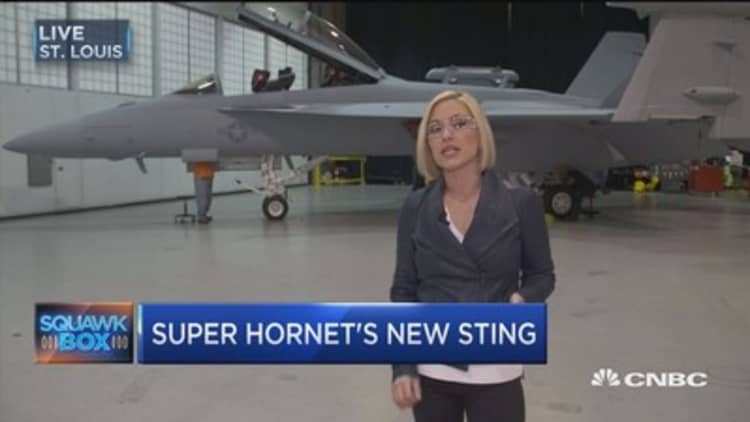
It's been the backbone of naval aviation for four decades and now, as President Donald Trump has repeatedly called attention to the program, the F-18 is getting a second life.
Last week, the final 2017 federal budget allotted $1.1 billion for 14 new Super Hornet fighter jets.
While it wasn't the 24 fighter jets at $2.3 billion the president had proposed in his supplemental budget proposal, it marked a win nonetheless: the original Defense Department budget proposal, released early last year, had requested none.
"We always thought that the Navy buying additional Super Hornets made sense because they need airplanes to last into the 2040s," said Dan Gillian, head of Boeing's F/A-18 and EA-18 programs.
Of course Boeing would think that — and it may have made sense. Still, until recently, the F-18 program had been viewed by many to be a production line on life support, as newer planes including Lockheed Martin's F-35 Joint Strike Fighter roll off assembly lines and into future U.S. carrier air wings.
Now, "St. Louis and the fighter business stays on for the next round of programs," said Richard Aboulafia, vice president of analysis at Virginia-based industry consultancy Teal Group. "It didn't look like that would be the case a year ago. Super Hornet orders had been expected to be down by end of decade."
Boeing's St. Louis, Missouri-based F-18 assembly line complex is currently turning out EA-18G Growlers, the jamming planes outfitted from Super Hornets, for the fiscal 2015 budget year. That year the Navy only ordered Growlers. The following year's budget included five Super Hornets, but the 2017 budget that just passed through Congress is the one that will prove to be an inflection point.
"Today we're producing two shipsets per month — Super Hornets and Growlers — in this factory," said Gillian, clad in safety goggles as he walks the plant floor, past stations stocked with workers and plane parts.
"As we think about the U.S. Navy's demands for additional airplanes to address the Super Hornet shortfall, as we think about their international demands, we can see that going up to 3 or 4 per month sometime in the early 20s," he said.
Boeing anticipates the U.S. Navy will purchase at least another 100 F/A-18s in the five budget cycles beginning with 2018, ensuring its place on aircraft carriers through the next two decades.
The long game, however, isn't the plane it's gearing up to manufacture for its 2016 and 2017 orders. Rather, it's the adoption of a new version called "Block III," which Boeing hopes the Navy will opt for before the decade is out.
Block III has a longer life cycle, and more advanced avionics that would better complement the F-35C, EA-18G Growler, and other planes comprising the air wing. The aircraft would act as a smart "node" on the naval fighter "network," Gillian said.
Block III is based off of the Advanced Super Hornet the company first unveiled in 2013, though today's version focuses less on stealth and more on capability. The general idea: a stealthy F-35 could conduct short-range reconnaissance and transmit that data back to the Super Hornet, which loaded with weapons, could pack the needed punch from farther away.
It's this plane that Trump likely had in mind when he asked Boeing to price a "comparable" plane to the fifth generation, stealthy F-35 — a move that caused industry experts to balk but also spurred a Pentagon review of the two fighters' operational capabilities.

Still Gillian is quick to stress that Boeing has been engaged in F/A-18 discussions with the Navy for years now, amid inventory shortages.
Earlier this year, Navy officials disclosed that two out of every three F-18 fighter planes in its fleet are out of commission on any given day, awaiting repairs. They've been flown hard in a post-9-11 world, which coupled with maintenance backlogs tied to budget cuts, has resulted in a serious maintenance bottleneck for all planes.
That coupled with delays for the naval variant of the F-35, which is now expected to be operational in 2018, and the Navy faces a fighter jet shortfall. This is the reason, analysts point out, the service has been pursuing more Super Hornet purchases as it pairs back F-35C orders — even before Trump entered the Oval Office.
Aboulafia said over the past five years, the Navy has requested about five times as many Super Hornets as F-35Cs.
Boeing has also developed a service life modification program to extend flight hours from 6,000 up to 9,000 for the more than 560 planes the Navy already operates, as the oldest Super Hornets begin to hit that max threshold in 2018.
Cost and timing will likely continue to dictate where future defense dollars go.
"The F/A-18 is the legacy fighter and the F-35 is the new fighter. The new fighter is going to have some improvements over the legacy fighter. It's going to be stealthier… and have a longer range. But those factors come at a price and I think President Trump has made it very clear that he's looking for the lowest price possible," said John Eade, president and senior analyst at New York-based Argus Research.
The Super Hornet currently costs between $70 million and $75 million, according to Boeing. An advanced version will add $3 million to that price tag.
By comparison, the naval variant of the F-35 is $121 million, according to the most recent government contract.
Boeing is pouncing on that cost component. In a one-page white paper obtained by Defense One, the company makes the argument for the Defense Department to buy more of its new advanced F/A-18s and fewer F-35Cs, suggesting the move would save tens of billions of dollars over 20 years.

